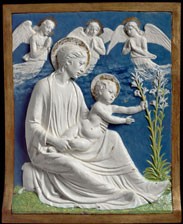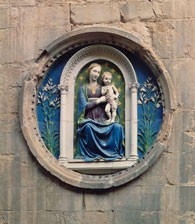Della Robbia: A Closer Look
In the rich artistic culture of 15th-century Florence, the sculptor Luca della Robbia (1399/1400–1482) won renown for his innovations in the medium of glazed terracotta. Praised as “new, useful, and most beautiful,” this distinctive technique involved the application of colorful, reflective glazes to sculptures in fired clay. Luca’s methods established a durable and shining surface for ceramic sculpture of many kinds, from independent statues in the round to narrative reliefs and architectural ornament. His family workshop specialized in depictions of sacred history and devotional images of the Madonna and Christ child for a variety of settings, including altars and chapels within churches, exterior walls and gates, and the domestic realm. The sculptures’ humble materials expressed the spiritual value of humility, exalted by a luminous surface, while the skill with which they were fashioned and the visual clarity of the medium made them easy to read and understand. Through pure, expressive color and a refreshing simplicity of means, Della Robbia terracottas illuminated themes of salvation through Christian faith.
Luca collaborated closely for decades with his nephew, Andrea (1435–1525), who entered his workshop by 1451 and inherited it in 1482. Five of Andrea’s children joined the enterprise, carrying the family’s art into the 16th century. As their range of commissions grew, the Della Robbia increasingly explored other genres, such as portraiture, still life, landscape, and allegory, alongside canonical religious subjects. Della Robbia sculptures still grace the churches and squares of Florence and other Italian cities, while portable reliefs, statuettes, and busts by the family adorn museums throughout the world. This major loan exhibition is the first devoted to the Della Robbia in the United States, where a newfound appreciation for the beauty and ingenuity of Renaissance glazed ceramics emerged in the 19th century and continues today.
Further information is available in the book accompanying the exhibition, Della Robbia: Sculpting with Color in Renaissance Florence, by Marietta Cambareri with Abigail Hykin and Courtney Leigh Harris (Boston: MFA Publications, 2016).
Click below for two features: Materials and Techniques of Della Robbia Sculpture, and Della Robbia Sculpture in Florence.

Luca della Robbia, Madonna and Child
with Lilies, c. 1460–1470, Museum of
Fine Arts, Boston. Gift of Quincy Adams
Shaw through Quincy Adams Shaw, Jr.,
and Mrs. Marian Shaw Haughton, 17.1476

Luca della Robbia, Coat of Arms of the
Guild of Doctors and Apothecaries, c.
1460, Orsanmichele, Florence. Photograph:
Scala/Art Resource, NY
